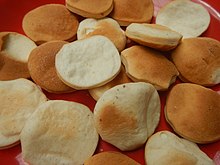
Lipa, officially the City of Lipa, is a 1st class component city in the province of Batangas, Philippines. According to the 2020 census, it has a population of 372,931 people.
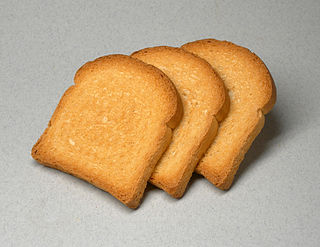
A rusk is a hard, dry biscuit or a twice-baked bread. It is sometimes used as a teether for babies. In some cultures, rusk is made of cake, rather than bread: this is sometimes referred to as cake rusk. In the UK, the name also refers to a wheat-based food additive.
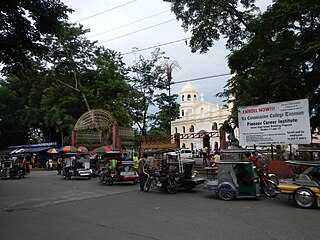
Tanauan, officially the City of Tanauan, is a 1st class component city in the province of Batangas, Philippines. According to the 2020 census, it has a population of 193,936 people.

Laurel, officially the Municipality of Laurel, is a 3rd class municipality in the province of Batangas, Philippines. According to the 2020 census, it has a population of 43,210 people.
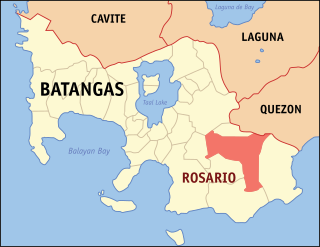
Rosario, officially the Municipality of Rosario, is a 1st class municipality in the province of Batangas, Philippines. According to the 2020 census, it has a population of 128,352 people.

Sto.Tomas, officially the City of Sto.Tomas, is a 1st class component city in the province of Batangas, Philippines. According to the 2020 census, it has a population of 218,500 people.
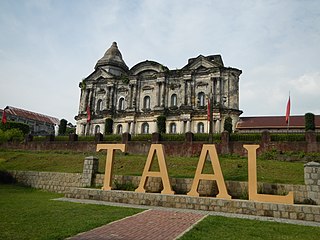
Taal, officially the Municipality of Taal, is a 3rd class municipality in the province of Batangas, Philippines. According to the 2020 census, it has a population of 61,460 people.
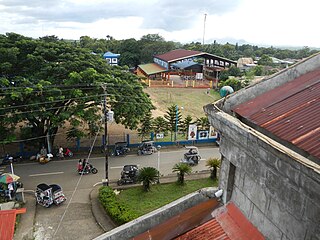
Tuy, officially the Municipality of Tuy, is a 3rd class municipality in the province of Batangas, Philippines. According to the 2020 census, it has a population of 46,519 people.

Biscocho, also spelled biskotso, refers to various types of Filipino twice-baked breads, usually coated with butter and sugar, or garlic in some cases. Biscocho is most strongly associated with the versions from the province of Iloilo, although it actually exists nationwide in various forms. It is also known as biscocho duro, machacao, or matsakaw. It is also historically known as pan de caña.

Pandesal, also known as Pan de sal is a staple bread roll in the Philippines commonly eaten for breakfast. It is made of flour, yeast, sugar, oil, and salt.

A half-moon cookie in Filipino cuisine is a semicircle- or crescent-shaped butter cookie. It has a soft crumbly texture and a sweet flavor with a salty aftertaste.

Mexican breads and other baked goods are the result of centuries of experimentation and the blending of influence from various European baking traditions. Wheat, and bread baked from it, was introduced by the Spanish at the time of the Conquest. The French influence in Mexican Bread is the strongest. From the bolillo evolving from a French baguette to the concha branching out from a French brioche even the terminology comes from France. A baño maría, meaning a water bath for a custard type budín or bread pudding comes from the French word bain marie. While the consumption of wheat has never surpassed that of corn in the country, wheat is still a staple food and an important part of everyday and special rituals. While Mexico has adopted various bread styles from Europe and the United States, most of the hundreds of varieties of breads made in the country were developed here. However, there is little to no baking done in Mexican homes; instead, Mexicans have bought their baked goods from bakeries since the colonial period.

Rosquillos are Philippine cookies made from flour, eggs, shortening, sugar, and baking powder. They were originally created by Margarita “Titay” T. Frasco in 1907 in Liloan, Cebu. The name means "ringlet" in Spanish and was reputedly coined by Philippine President Sergio Osmeña.

Local elections were held in Batangas on May 9, 2016, as part of the 2016 general election. Voters will select candidates for all local positions: a town mayor, vice mayor and town councilors, as well as members of the Sangguniang Panlalawigan, the vice-governor, governor and for the six districts of Batangas.

Barquillo is a crispy rolled wafer pastry originating in Spain. It is made from the basic cookie ingredients of flour, sugar, egg whites and butter rolled out thinly and then shaped into a hollow cylinder or a cone. It was traditionally sold by roadside vendors known as barquilleros who carried a characteristic red roulette tin. It was introduced to Latin America and the Philippines during colonial times. In Spain and former Spanish colonies, barquillos are commonly regarded as a type of Christmas cookie. It is also popular during various fiestas. It spread to neighboring countries and today is extremely popular in East and Southeast Asian countries.

Galletas de patatas, commonly sold as egg cracklets, are Filipino biscuits. They are characteristically thick and square-shaped with upturned edges. The name is derived from the curving browned lower edge which resembles a potato. It is also called galletas de huevos due to the use of egg-white glazing, or tengang daga due to its shape.

Jacobinas are Filipino biscuits. They are distinctively cubical in shape, resembling a thicker galletas de patatas. The square biscuit was first produced by the Noceda Bakery in 1947 at 78 Gen. Luna Street, Mendez, Cavite by Paterno Noceda, and JACOBINA was registered with the Intellectual Property Office of the Philippines in 1955. In 1975, La Noceda Food Products, Inc. was incorporated to produce the famous biscuits. The biscuits are sold by the Noceda bakery in the Philippines and by the Jacobina corporation in the United States and other Asian countries. Jacobinas are traditionally eaten paired with coffee for breakfast.

Ugoy-ugoy, also spelled ogoy-ogoy, are Filipino layered biscuits. They are typically rectangular or ribbon-like in shape and are topped with granulated sugar. It is particularly associated with the city of Iloilo.

Linga, also known as longa, are Filipino cookies originating from Davao del Sur in the Philippines. The name comes from sesame seeds, which are known locally as linga in the Visayan languages or longa in the Davaoeño language. They are made from flour, sugar, salt, shortening, and sesame seeds. They are characteristically flat and baked until they are a deep brown color. They range in shape and size from small and circular to large and oblong. They are usually dipped in hot drinks like coffee or tsokolate before eating.

Local elections were held in the province of Batangas on May 9, 2022 as part of the 2022 general election. Voters will select candidates for all local positions: a town mayor, vice mayor and town councilors, as well as members of the Sangguniang Panlalawigan, the vice-governor, governor and for the six districts of Batangas.
